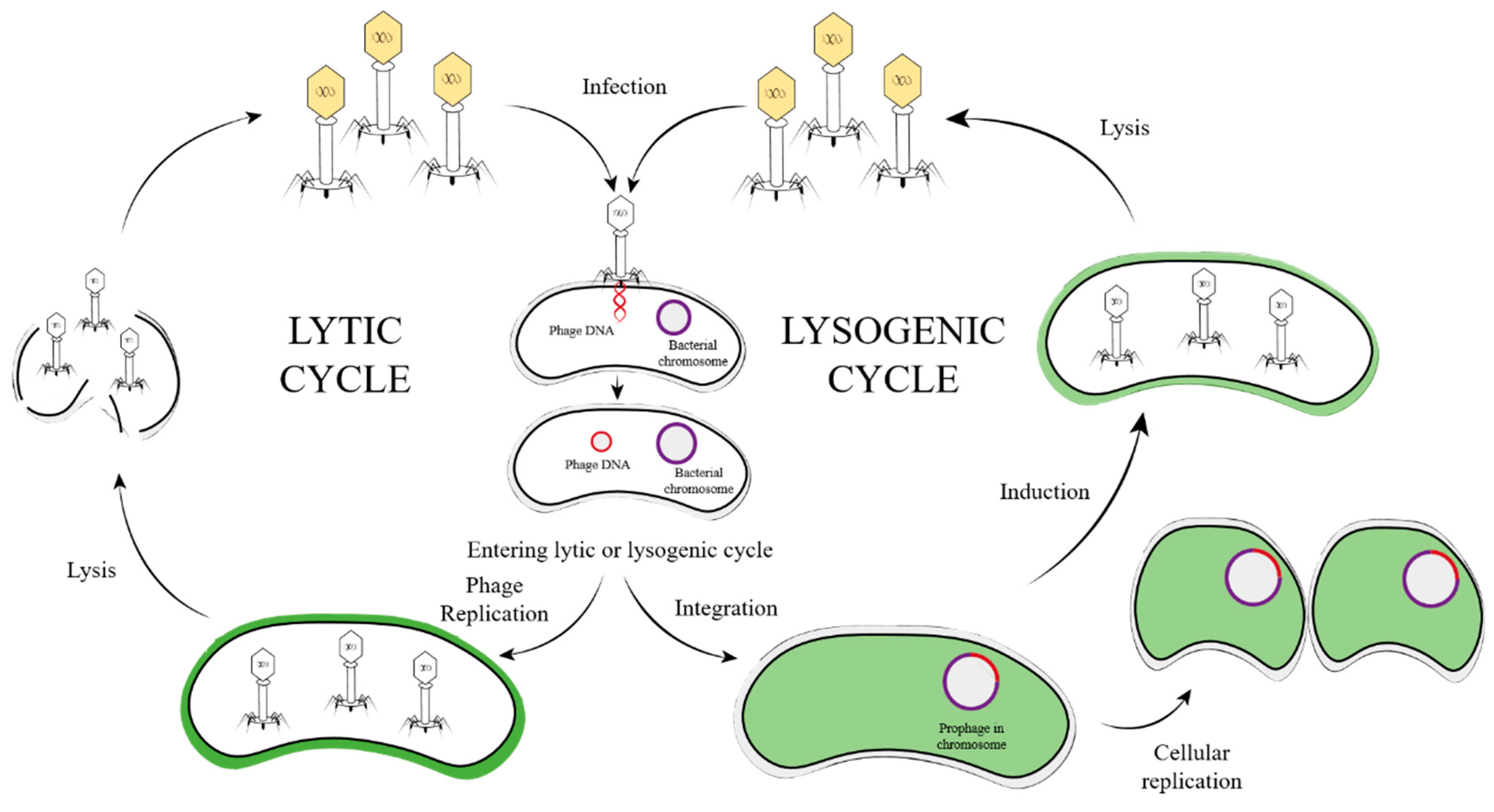The phage specimen you will use is already diluted to 1/ 1000, and you will dilute further. Bacteria and phage are mixed together in tubes of soft agar. The mix is incubated in the water bath. After incubation the mix is added to the soft agar and poured over the tryptone agar plates. Be SURE to mix the dilutions. Change pipettes between dilutions.
Viruses | Free Full-Text | Bacteriophages as Biotechnological Tools
The phage-typing procedure is sometimes employed in epidemiology to identify and trace the progress of an infectious agent This has been a standard procedure for strains of Staphylococcus aureus involved in outbreaks of food poisoning or other infections.

Source Image: microbeonline.com
Download Image
Phage typing is a phenotypic method that uses bacteriophages (“phages” for short) for detecting and identifying single strains of bacteria. [1] Phages are viruses that infect bacteria and may lead to bacterial cell lysis. [2] The bacterial strain is assigned a type based on its lysis pattern. [3]

Source Image: pubs.acs.org
Download Image
Phage typing is carried out in a few specialized laboratories, and thus is not commonly used. Geographic distribution of phage types of bioserotype 4,O:3 is recognized, as is the association of particular phage types of this bioserotype with the development of postinfection sequelae. Phage typing has largely been replaced by molecular typing.

Source Image: pubs.acs.org
Download Image
Describe How This Exercise Demonstrates The Principle Of Phage Typing
Phage typing is carried out in a few specialized laboratories, and thus is not commonly used. Geographic distribution of phage types of bioserotype 4,O:3 is recognized, as is the association of particular phage types of this bioserotype with the development of postinfection sequelae. Phage typing has largely been replaced by molecular typing.
Apr 24, 2022Principle of Phage Plaque Assay. When a suspension of an infective phage (e.g. T4 phage) is spread over the lawn of susceptible bacterial cells (e.g. Escherichia coli), the phage attaches the bacterial cell, replicate inside it, and kills it during its lytic release.Lysis of the bacteriophage is indicated by the formation of a zone of clearing or plaque within the lawn of bacteria.
Renaissance for Phage-Based Bacterial Control | Environmental Science & Technology
Biology Biology questions and answers 92 – EXERCISE 14 6. Describe how this exercise demonstrates the principle of phage typing 7. List other biological examples in which specific protein interactions are involved? This problem has been solved! You’ll get a detailed solution from a subject matter expert that helps you learn core concepts.
Phage typing – Wikipedia

Source Image: en.wikipedia.org
Download Image
Biology Biology questions and answers 92 – EXERCISE 14 6. Describe how this exercise demonstrates the principle of phage typing 7. List other biological examples in which specific protein interactions are involved? This problem has been solved! You’ll get a detailed solution from a subject matter expert that helps you learn core concepts.

Source Image: mdpi.com
Download Image
Phage typing is a phenotypic method that uses bacteriophages (“phages” for short) for detecting and identifying single strains of bacteria. [1] Phages are viruses that infect bacteria and may lead to bacterial cell lysis. [2] The bacterial strain is assigned a type based on its lysis pattern. [3]

Source Image: mdpi.com
Download Image
The phage specimen you will use is already diluted to 1/ 1000, and you will dilute further. Bacteria and phage are mixed together in tubes of soft agar. The mix is incubated in the water bath. After incubation the mix is added to the soft agar and poured over the tryptone agar plates. Be SURE to mix the dilutions. Change pipettes between dilutions.

Source Image: mdpi.com
Download Image
A bacteriophage is a virus that infects bacteria. A bacteriophage, or phage for short, is a virus that infects bacteria. Like other types of viruses, bacteriophages vary a lot in their shape and genetic material. Phage genomes can consist of either DNA or RNA, and can contain as few as four genes or as many as several hundred 1, 2, 3.

Source Image: mdpi.com
Download Image
Phage typing is carried out in a few specialized laboratories, and thus is not commonly used. Geographic distribution of phage types of bioserotype 4,O:3 is recognized, as is the association of particular phage types of this bioserotype with the development of postinfection sequelae. Phage typing has largely been replaced by molecular typing.

Source Image: mdpi.com
Download Image
Apr 24, 2022Principle of Phage Plaque Assay. When a suspension of an infective phage (e.g. T4 phage) is spread over the lawn of susceptible bacterial cells (e.g. Escherichia coli), the phage attaches the bacterial cell, replicate inside it, and kills it during its lytic release.Lysis of the bacteriophage is indicated by the formation of a zone of clearing or plaque within the lawn of bacteria.

Source Image: chegg.com
Download Image
IJMS | Free Full-Text | The Burden of Survivors: How Can Phage Infection Impact Non-Infected Bacteria?
Solved Lab Report: 14 Bacteriophage Specificity 1. What was | Chegg.com
The phage-typing procedure is sometimes employed in epidemiology to identify and trace the progress of an infectious agent This has been a standard procedure for strains of Staphylococcus aureus involved in outbreaks of food poisoning or other infections.
Cancers | Free Full-Text | High-Throughput Monoclonal Antibody Discovery from Phage Libraries: Challenging the Current Preclinical Pipeline to Keep the Pace with the Increasing mAb Demand CIMB | Free Full-Text | Disarm The Bacteria: What Temperate Phages Can Do
A bacteriophage is a virus that infects bacteria. A bacteriophage, or phage for short, is a virus that infects bacteria. Like other types of viruses, bacteriophages vary a lot in their shape and genetic material. Phage genomes can consist of either DNA or RNA, and can contain as few as four genes or as many as several hundred 1, 2, 3.